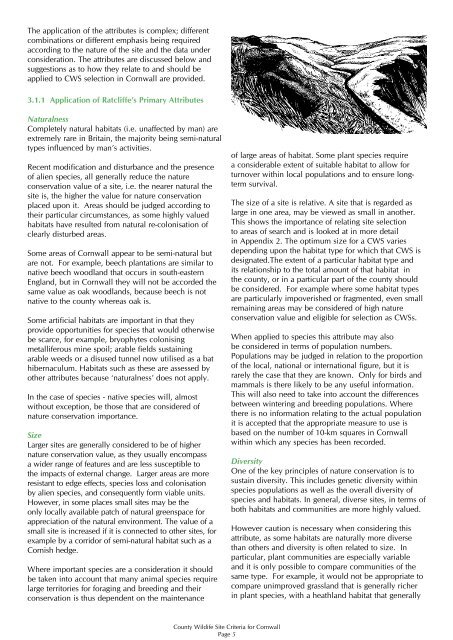County Wildife Site Criteria for Cornwall - Cornwall Wildlife Trust
County Wildife Site Criteria for Cornwall - Cornwall Wildlife Trust
County Wildife Site Criteria for Cornwall - Cornwall Wildlife Trust
Create successful ePaper yourself
Turn your PDF publications into a flip-book with our unique Google optimized e-Paper software.
The application of the attributes is complex; differentcombinations or different emphasis being requiredaccording to the nature of the site and the data underconsideration. The attributes are discussed below andsuggestions as to how they relate to and should beapplied to CWS selection in <strong>Cornwall</strong> are provided.3.1.1 Application of Ratcliffe’s Primary AttributesNaturalnessCompletely natural habitats (i.e. unaffected by man) areextremely rare in Britain, the majority being semi-naturaltypes influenced by man’s activities.Recent modification and disturbance and the presenceof alien species, all generally reduce the natureconservation value of a site, i.e. the nearer natural thesite is, the higher the value <strong>for</strong> nature conservationplaced upon it. Areas should be judged according totheir particular circumstances, as some highly valuedhabitats have resulted from natural re-colonisation ofclearly disturbed areas.Some areas of <strong>Cornwall</strong> appear to be semi-natural butare not. For example, beech plantations are similar tonative beech woodland that occurs in south-easternEngland, but in <strong>Cornwall</strong> they will not be accorded thesame value as oak woodlands, because beech is notnative to the county whereas oak is.Some artificial habitats are important in that theyprovide opportunities <strong>for</strong> species that would otherwisebe scarce, <strong>for</strong> example, bryophytes colonisingmetalliferous mine spoil; arable fields sustainingarable weeds or a disused tunnel now utilised as a bathibernaculum. Habitats such as these are assessed byother attributes because ‘naturalness’ does not apply.In the case of species - native species will, almostwithout exception, be those that are considered ofnature conservation importance.SizeLarger sites are generally considered to be of highernature conservation value, as they usually encompassa wider range of features and are less susceptible tothe impacts of external change. Larger areas are moreresistant to edge effects, species loss and colonisationby alien species, and consequently <strong>for</strong>m viable units.However, in some places small sites may be theonly locally available patch of natural greenspace <strong>for</strong>appreciation of the natural environment. The value of asmall site is increased if it is connected to other sites, <strong>for</strong>example by a corridor of semi-natural habitat such as aCornish hedge.Where important species are a consideration it shouldbe taken into account that many animal species requirelarge territories <strong>for</strong> <strong>for</strong>aging and breeding and theirconservation is thus dependent on the maintenanceof large areas of habitat. Some plant species requirea considerable extent of suitable habitat to allow <strong>for</strong>turnover within local populations and to ensure longtermsurvival.The size of a site is relative. A site that is regarded aslarge in one area, may be viewed as small in another.This shows the importance of relating site selectionto areas of search and is looked at in more detailin Appendix 2. The optimum size <strong>for</strong> a CWS variesdepending upon the habitat type <strong>for</strong> which that CWS isdesignated.The extent of a particular habitat type andits relationship to the total amount of that habitat inthe county, or in a particular part of the county shouldbe considered. For example where some habitat typesare particularly impoverished or fragmented, even smallremaining areas may be considered of high natureconservation value and eligible <strong>for</strong> selection as CWSs.When applied to species this attribute may alsobe considered in terms of population numbers.Populations may be judged in relation to the proportionof the local, national or international figure, but it israrely the case that they are known. Only <strong>for</strong> birds andmammals is there likely to be any useful in<strong>for</strong>mation.This will also need to take into account the differencesbetween wintering and breeding populations. Wherethere is no in<strong>for</strong>mation relating to the actual populationit is accepted that the appropriate measure to use isbased on the number of 10-km squares in <strong>Cornwall</strong>within which any species has been recorded.DiversityOne of the key principles of nature conservation is tosustain diversity. This includes genetic diversity withinspecies populations as well as the overall diversity ofspecies and habitats. In general, diverse sites, in terms ofboth habitats and communities are more highly valued.However caution is necessary when considering thisattribute, as some habitats are naturally more diversethan others and diversity is often related to size. Inparticular, plant communities are especially variableand it is only possible to compare communities of thesame type. For example, it would not be appropriate tocompare unimproved grassland that is generally richerin plant species, with a heathland habitat that generally<strong>County</strong> <strong>Wildife</strong> <strong>Site</strong> <strong>Criteria</strong> <strong>for</strong> <strong>Cornwall</strong>Page 5
















